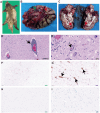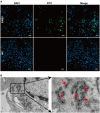First isolation of rabies virus from a Eurasian badger (Meles meles) in Inner Mongolia, China, 2024
- PMID: 40636809
- PMCID: PMC12237657
- DOI: 10.3389/fvets.2025.1598528
First isolation of rabies virus from a Eurasian badger (Meles meles) in Inner Mongolia, China, 2024
Abstract
Rabies continues to pose a significant global zoonotic threat. In recent years, the increased spillover events of rabies viruses from wildlife to domestic animals have raised public health security concerns, prompting heightened international attention toward rabies management in wildlife populations. Our study reveals the first documented case of a rabies virus (RABV) strain isolated from Eurasian badgers (Meles meles) within Chinese ecosystems. Genetic analysis shows 99.4% nucleotide identity with dominant bovine-associated cosmopolitan lineages, offering robust evidence of interspecies transmission from wildlife reservoirs to domestic livestock. It is noteworthy that due to the special geographical location of this region, the habitat of Eurasian badgers overlaps with the territory of livestock and human settlements, thereby forming a transmission chain of rabies virus such as "fox- Eurasian badger-livestock" or "Eurasian badger-livestock." This critical finding highlights an urgent need for enhanced pathogen surveillance programs in pastoral regions where intensive human-wildlife-livestock interfaces create high-risk transmission zones.
Keywords: Eurasian badger; livestock; phylogenetic analysis; public health; rabies virus; virus isolation; zoonotic disease.
Copyright © 2025 Chen, Bao, Aodun, Zhang, Zhang, Gao, Qiao, Liu, Liu and Zhang.
Conflict of interest statement
The authors declare that the research was conducted in the absence of any commercial or financial relationships that could be construed as a potential conflict of interest.
Figures



Similar articles
-
The Challenge of Lyssavirus Infections in Domestic and Other Animals: A Mix of Virological Confusion, Consternation, Chagrin, and Curiosity.Pathogens. 2025 Jun 13;14(6):586. doi: 10.3390/pathogens14060586. Pathogens. 2025. PMID: 40559594 Free PMC article. Review.
-
Emergence and Evolution of Novel Reassortant Influenza A Viruses in Canines in Southern China.mBio. 2018 Jun 5;9(3):e00909-18. doi: 10.1128/mBio.00909-18. mBio. 2018. PMID: 29871917 Free PMC article.
-
Sexual Harassment and Prevention Training.2024 Mar 29. In: StatPearls [Internet]. Treasure Island (FL): StatPearls Publishing; 2025 Jan–. 2024 Mar 29. In: StatPearls [Internet]. Treasure Island (FL): StatPearls Publishing; 2025 Jan–. PMID: 36508513 Free Books & Documents.
-
Temporal and Spatial Analysis of Rabies Virus Lineages in South Africa.Viruses. 2025 Feb 28;17(3):340. doi: 10.3390/v17030340. Viruses. 2025. PMID: 40143269 Free PMC article.
-
Diseases at the livestock-wildlife interface: status, challenges, and opportunities in the United States.Prev Vet Med. 2013 Jun 1;110(2):119-32. doi: 10.1016/j.prevetmed.2012.11.021. Epub 2012 Dec 14. Prev Vet Med. 2013. PMID: 23254245 Free PMC article.
References
LinkOut - more resources
Full Text Sources

